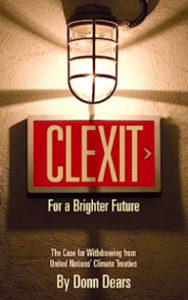
by Donn Dears
Clexit is a follow-up to Dears 2015 book, Nothing to Fear. Clexit explains why the United States should withdraw from the United Nations Framework Convention on Climate Change (UNFCCC) treaty.
Dears describes the impossibility of cutting carbon dioxide (CO2) and other greenhouse gas (GHG) emissions enough to slow or stop climate change. Since the UNFCCC s purpose is to achieve, in accordance with the relevant provisions of the Convention, stabilization of greenhouse gas concentrations in the atmosphere at a level that would prevent dangerous anthropogenic interference with the climate system, and since achieving that purpose is impossible, the United States should withdraw. Dears explains why participating in, and funding, a failed treaty is immoral.
Chapter 1, The UNFCCC, explains what the treaty is, what it aims to accomplish, and what it means for the United States.
Chapter 2, Worldwide CO2 Emissions, answers the question: Can CO2 emissions be cut 50% worldwide by 2050, or will there be a climate catastrophe?
Chapter 3, Cutting U.S. CO2 emissions 80%, answers the question: Can U.S. CO2 emissions be cut 80% by 2050 as former President Barack Obama and the Environmental Protection Agency insist we must do. Dears concludes the United States cannot cut electricity emissions 80 percent.
Chapter 4, Cutting U.S. Gasoline Use 80%, discusses electric vehicles and fuel-cell vehicles, concludes the United States cannot cut emissions from its transportation fleet by 80 percent.
Chapter 5, Comments on the UNFCCC Treaty, offers commentary on several provisions of the treaty.
Appendix 1 discusses the unworkability of carbon capture and sequestration.
Appendix 2 discusses alternative uses of CO2, explaining, “Nothing is on the horizon to convert CO2 to some other product that would affect how to dispose of captured CO2 between now and 2050.”
Appendix 3 discusses options for energy storage.
Appendix 4 discusses the decline of nuclear power in the United States.
Appendix 5 is the text of the UNFCCC Treaty, annotated for easy reference to the comments made in Chapter 5.
About the Author
Donn spent his career at General Electric Company in the power sector, leading organizations that provided engineering services for GE’s large electrical apparatus. Donn led the establishment of GE subsidiary companies around the world and actively participated in providing engineering services to a wide range of industries including electric utilities, steel, mining and transportation.
He retired as a senior GE Company executive and served on active duty in the Navy during the Korean War.
Donn Dears
